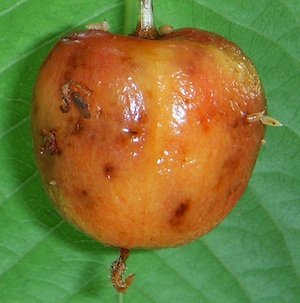Entomologists who are working with the spotted wing drosophila are trying to refine their monitoring techniques so they can correlate number of flies trapped to number of flies that are actually in the orchards and to give greater meaning to the results.
Spotted wing drosophila (Drosophila suzukii) is a tiny fruit-feeding insect that appeared in the Pacific Northwest in the fall of 2009. Unlike its relative, the common fruit or vinegar fly, which attacks only mature fruit, the spotted wing drosophila attacks fruit on the tree.
Oregon State University entomologist Dr. Peter Shearer, speaking to growers at the Mid-Atlantic Fruit and Vegetable Convention, said the favored trap has been a clear plastic deli-cup, with a cover, filled about halfway with apple cider vinegar and water, with a bit of soap added to make sure the surface tension is broken and the insect sinks.
Sometimes, salt is added to prevent freezing. Since the insect does not enter diapause, trapping can continue into winter, and catches have been made when temperatures reach 50˚F.
“It now appears the clear cups are the worst color trap to use,” he said. “Clear is what we’ve been using, but red seems best.” Orange, white, and black traps caught similar amounts of flies, but all caught more than clear cups.
In tests last year, traps baited with yeast, sugar, and water caught a lot more flies than apple cider vinegar, and caught them earlier, he said.
“We’ve also got to look for females. They’re harder to identify than males, but they are definitely there first. Last year, females were caught in traps anywhere from 5 to 21 days earlier than males.”
Several commercial traps were also evaluated last year to see if they performed better.
Shearer said researchers also found that the flies changed in appearance as the season went on, becoming larger and darker in the fall and, apparently, having greater fat reserves going into the winter.
There seems also to be a sizeable reservoir of the flies—coming in from urban areas, from compost piles, and from wild fruit. Although, on that note, he said, “Cherries are infesting wild blackberries and not the other way around.”
Trapping also showed there was no edge effect in orchards. “Once the fruit is ripe, flies are everywhere,” he said. Border sprays would not be a way to cut control costs.
For more information about this pest, see the article “Spotted wing drosophila challenges growers,” in the May 15 edition of the Good Fruit Grower print magazine.


Leave A Comment